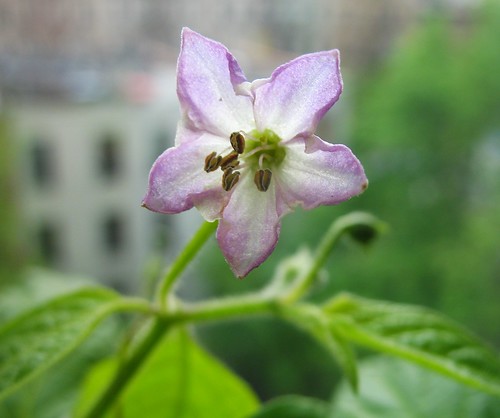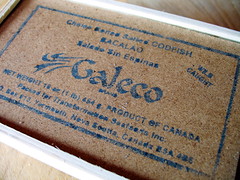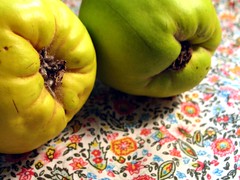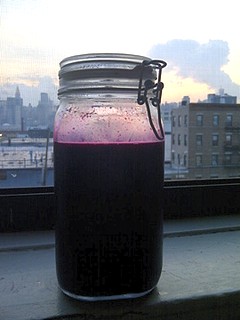I've been experimenting with urban container gardening for many years now, with what is commonly referred to as "limited success." Meaning that I am perpetually enthusiastic about trying to grow edible stuff, in a series of NYC apartments ranging from ridiculously- to moderately-unsuitable for that purpose, and I tend not to research my little gardening projects before I get started. I don't know why but this is how it's always been. I happily research other things, probably over-research at times, but when it comes to plants I just get emotional. I fervently want to grow something, or I don't. I've written on my other blog that I find people's ambitions for their plants weirdly touching — e.g., the sort of little old ladies who call in to Gardeners' Question Time wanting to know how to grow bananas in Dorset — but I am so emotional about plants that I truly did not have any sense at the time that I may have been referring to myself.
I don't have a desire to grow bananas (well, not a serious one, apart from these pink ones, which surely you can understand) but I was dead set on growing mushrooms in componibili. I was going to have a whole mushroom farm inside my componibili and then, eventually, a very good excuse to buy more componibili units. The problem is it's damn hard to remember the mushrooms are in there and need tending. I ended up with a little box of mushroom dust. The accidental kind, not the kind one invites beardos over to sample.
My experimentation started with pots of herbs and for years I remained focused on those rather than attempting to grow any vegetables or fruits. I love herbs and will never have too many around for cooking with, but I wish I'd branched out sooner. My experience has been that a lot of herbs are actually rather fussy about how they are cared for — especially the ones I was most eager to have a steady home-grown supply of, like lovage and za'atar — whereas fruits and veg are maybe more tolerant of an inept, pale green thumb than I thought.
So, Alpine strawberries in Harlem, why not? So far they're thriving, more so than anything else I've ever grown. I ordered six varieties of "quick start" plants from The Strawberry Store and planted them in a white window box filled with organic soil. (My understanding is that strawberries don't like it if their roots get hot so a dark-colored planter should be avoided). They spent two chilly weeks on my fire escape while I worried about them being rained on too much, not rained on enough, and tormented by strong winds before the first berries started to appear. Hooray!
An updated shot of the same berry I showed you earlier this week.
These are the varieties I'm growing:
- Madame Moutot: The Strawberry Store describes these as "[a] tried and tested French variety that was released in 1906. . . . The delicious red fruit of this variety doesn't ship well which is one reason commercial acreage has decreased in Europe. Gardeners in Europe still consider this to be a standard." Which all sounds very nice, but it was the name that drew me. I want Mesdames Moutot snuggling in my breakfast yogurt. It looks like I'll have that happening sooner rather than later because this variety has been the first to set fruit.
- Yellow Wonder: I'd been eyeing these on other people's blogs for years but kept missing the window of time for germinating seeds, so I was really excited to find them in starter plant form. The Strawberry Store people say that "[i]f you are going to choose one non red variety, this is it." I hope mine turn out to be long and pointy and shaggy-looking the way other people's yellow ones are.
- Fragola di Bosco: These are "one of the two Italian varieties [they] carry. The plants are vigorous and day-neutral and everbearing. They produce a nice quantity of larger than usual red fruit." Vigorous berries appeal to the beginning berry-grower. Italian strawberries are chic and appeal to everyone, no?
- Reine des Vallees: These sounded like a must-have too. "The name of this very popular variety in English means 'Queen of the Valleys'. This one was very difficult to find. This variety is the commercial standard in Europe and has been for a number of years. . . . 'Reine des Vallees' is very productive and produces red aromatic fruit. We are impressed with this variety and think it should become the American standard."
- Deesse des Vallees: "French for Goddess of the Valleys. To my knowledge this variety has never before been made available in North America. It is a patented selection of 'Reine des Vallees' which translates to Queen of the Valleys." Clearly I needed these for comparison purposes.
- Regina: "'Regina' is an excellent variety. It is known in Poland as Poziomka 'Regina' and is a standard variety there. The vigorous plants produce aromatic red fruit." I just have a feeling that Poles know their strawberries and would not deem an undeserving variety to be the Regina of all the other strawberries. People who make fluffy butter lambs simply would not do such a thing.
Canadians have developed a monster of a strawberry, probably
using the same technology they grow their beards with,
but I'm sticking with little Alpine ones
The only vegetables I've grown with any success to date are chili
peppers. Meaning that I have two pepper plants and last summer they
produced one pepper, which I harvested and ate with the ponderous,
quasi-mystical regard the occasion seemed to call for.
What the hell to do with one lonely chili pepper? I thought, I waited, I considered making a spicy cocktail, and then late one night I decided it was harvest time and sliced the thing over a couple of fried eggs, which I topped with home-grown (and far less troublesome) marjoram leaves. It was hot enough to be proud of and lovely to eat.
My
pepper plants are one mystery variety (said to be habanero when purchased, but
in actuality probably serrano) and one rocoto (which I started from seed, and which is actually two plants co-habitating in one pot).
The mystery plant is the one that produced the pepper I ate, but it looks like
I'll finally be able to harvest some rocotos this summer. I only recently realized that I should have re-potted the poor plants long, long ago.
I was ignoring them (a long, depressing story involving love trouble, obviously) and now that they're in a bigger pot they seem much happier, growing
rapidly and flowering with enthusiasm.
The flowering part can be tricky because flowers need to be pollinated. I suspect the reason I only got one pepper
out of my mystery plant last summer was because it spent all its time
indoors, away from sexy insects, dependent on my amateurish little
attentions with a watercolor brush. Other people on the internet will
tell you that gently doing stuff to your pepper plant flowers with a brush is sufficient, but I don't think it is. This year my peppers are
both spending some quality time outdoors on the fire escape, and getting some
extra action from me too. I can't believe I'm telling you this, but . .
. I have been rubbing their flowering parts together
Barbie-and-Ken-and-Barbie's-friend-style, if you know what I mean. I'll be sure to keep you posted as to whether or not they seem to be into it.






























It sounds like they've gotten nicely over their love trouble.
ReplyDeleteHard to say, they were literally climbing out of their inadequate little pot. Whether in search of a ledge or hotter rebound peppers to get pollinated by I don't know.
ReplyDelete